
Newsletter of the Shell Club of Sydney
NSW Branch, The Malacological Society of Australasia Limited ACN 067 894 848
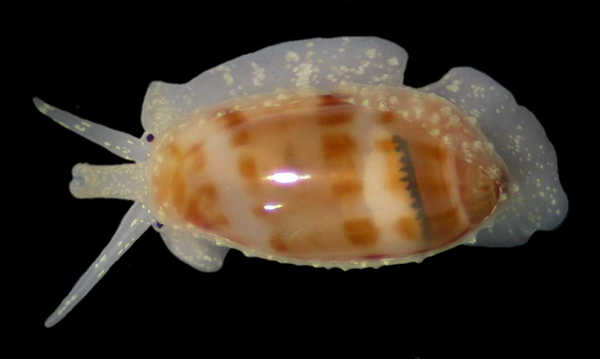
Haloginellla mustelina (Live Margin Shell) Shell Harbour
Field Trip - Patty Jansen
In this Issue:
- Mysterious Marine Spiders in Sydney
Harbour
- Conotoxins - going the next step
- Research Dredging in Broken Bay
- Long bay field trip pictures
- Field Trip to Shell Harbour
- Shell Club Library
- What makes a good shell book?
- Puzzles
- Sydney Shell Collectors Club Inc Web Site
- Minutes
Mysterious Marine Spiders in Sydney Harbour:
Help wanted!
Dr Mike Gray, Australian Museum
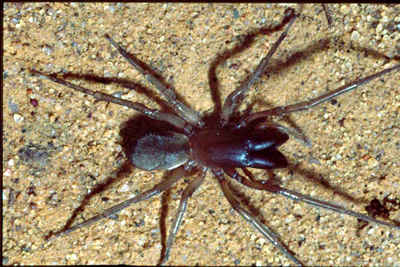
Spiders are pretty adaptable creatures so it's not too surprising that some have colonised the intertidal zone around Australia's coast and further
a field (Africa, India, New Zealand, Oceania and north to Japan). These "marine spiders" can live fully immersed on rocky shores and reefs for many hours or days at a time.
Note that I am talking about genuine spiders here, not the so-called "Sea Spiders" or Pycnogonida. Pycnogonids are fully marine animals with long, slender legs and tiny bodies.
Those weird-looking, leggy beasts are often seen underwater among seaweed or picked up in dredge samples.
The commonest intertidal spiders belong to the genus Desis, and it is to this group that the term "marine spiders" is usually applied. I am doing a taxonomic review of the Australian species and would like to locate more spiders, especially locally, and learn more about their behaviour.
Marine spiders are about 1 cm in body length, about the size of the familiar window or black house spiders. An obvious and unique feature is the large, projecting jaws. The body is somewhat elongate, with a variable colour pattern of a brownish head and jaws and greyish abdomen.
Unfortunately, marine spiders are rarely reported or collected, so one assumes
they are also rarely seen. This is something I hope to determine from your responses to this story. They were last recorded from Sydney Harbour some 70 years ago! Reports over the last 50 years suggest they are common in some areas of the Great Barrier Reef. For example, in 1952 Alfred Read found numerous specimens living among broken coral and shell debris on the reef at Low Island, several hundred metres offshore. On some parts of the reef, spiders were completely immersed for up to 5 days at a time (North Queensland Naturalist 20 (100): 9-11). Marine spiders have been reported from many Barrier Reef localities.
Marine spiders are known from other parts of the Australian coast, but reports and collections of them are relatively scarce.
Desis kenyonae Pocock 1902 was described for spiders from San Remo, Westernport Bay, Victoria, and Hickman described male spiders from Eaglehawk Neck, Tasmania (1949, Papers & Proceedings of the Royal Society of Tasmania 1948: 31-43) as
Desis kenyonae (in fact, the Tasmanian spiders are probably a new species).
Desis spiders are also recorded from Sydney Harbour. As long ago as 1898, H.H. Whitelegge collected specimens from "Taylors Bay and Watson's Bay in Port Jackson" where "There is a very common species of spider found under stones about low water mark." (Journal of the Royal Society of NSW 23: 233). The Australian Museum collections contain specimens collected in the early 1930s from "Port Jackson" and Bottle & Glass Rocks (Vaucluse Point).
Limited searching in the harbour so far has not located any marine spiders. This suggests that the spiders are either no longer "very common" or are patchily distributed. The worst, but least likely possibility, is that they are locally extinct in Sydney Harbour.
It would be good to disprove this possibility. There are many rocky shore habitats around Sydney Harbour that could be home to these spiders. Reports suggest that they are seen moving about or sitting in small silk shelters when turning rocks or shells in the intertidal zone of rocky shores or reef platforms . The spiders have been reported as making small silk retreats in cavities in rocks and under seaweed holdfasts, in calcareous worm tubes and holes, and in shells. The cavity openings may be closed by a small sheet of whitish silk. These "cavity microhabitats" provide air pockets into which the spider can retreat and survive its long underwater immersions. However, in some cases the spider's retreats were found in spaces between clustered calcareous tubeworm stems with apparently only the silk walls of its sac-like refuge between the spider and the sea. Apart from anecdotal observations, very little is known about the habits and life cycle of these spiders. Their relationships also are not clear and they may even be the sole representatives of their family - the Desidae.
If anyone has seen marine spiders in the Sydney region, recently or in the past, it would be appreciated if they could contact Mike Gray with details. Records from Sydney Harbour and environs are especially sought, but any other Australian records also would be very useful.
Mike Gray
Australian Museum
6 College St Sydney 2010
email: mikeg@austmus.gov.au
fax: 02 9320 6050
Phone:02 9320 6135
AH 02 9477 2514
Conotoxins - going the next step
Bruce Livett
Dear Steve, Patty, I visited your site and wish to congratulate you on having a presence on the web. Way to go !
I was in Sydney for three days at the end of March to present a poster at the Commercialization and Innovation
Fair, Darling Harbour.
We prepared the poster as a prospectus for the features of a novel analgesic that we have recently identified in the venom of an Australian cone shell,
Conus victoriae.
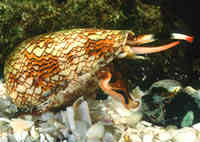
We have an international patent application lodged and are seeking a commercial partner to develop this compound as a drug to treat chronic neuropathic pain.
Presently such painful conditions as terminal cancer and AIDS and phantom limb syndrome and shingles and diabetic leg ulcer (to name a few) are treated with opioid drugs such as morphine. However, morphine causes dependence and at the higher doses needed to achieve relief from pain it causes unwanted side effects such as constipation and nausea. Not pleasant. Hence the need for a supplement or replacement to morphine. Fortunately, the cone shell has had 500 million or so years to get its act together and develop an analgesic that it uses to sedate its prey as part of the envenomation attack. We are merely rediscovering the wheel and putting all this to good use, hopefully, to provide relief for many for whom morphine is no longer effective against their pain.
The Innovation Fair was one way of making our basic (malacological) research known to potential developers and investors. A
small extract from the poster follows.
"ACV1: a potent novel non-addictive analgesic biopharmaceutical licensing opportunity.
ACV1 is a potent novel analgesic that has the potential for wide-reaching applications in the treatment of Chronic Pain. It is a short length peptide based on a natural compound,
a conotoxin, found in the venom of an Australian cone shell (Conus
victoriae).

Chronic pain, resulting from cancer, AIDS, arthritis or injury, afflicts almost 60% of people in the developed world at some time in their lives.
Chronic neuropathic pain is predominantly treated with morphine. However, morphine causes dependence, and at the higher doses required to maintain a level of analgesia it produces undesirable side-effects including constipation, respiratory depression and dysphoria. Many physicians are loathe to prescribe the ‘gold standard’ of opioid drugs, morphine, for chronic neuropathic pain.
Opioids benefit only some people with neuropathic pain, hence the need for a complement to or substitute for morphine that would be free of these unwanted side-effects and be free of tolerance and dependence.
ACV1 is a patented small compact peptide. It has proved in animal studies to be a potent novel analgesic effective against chronic pain.
It has the additional property that it accelerates the rate of functional recovery from a nerve injury. It is a neuronal-type nicotinic acetylcholine receptor antagonist.
"
Research Dredging in Broken Bay
By Steve Dean
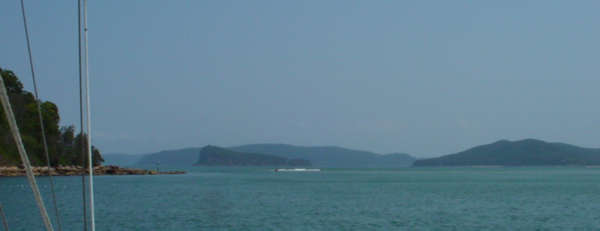
A few years back Peter Middelfart gave a talk at our meeting about
research he was doing to update the species lists of a family of 'small
white bivalves'. The end result was that a number of the original named
species were not valid, being synonyms of others, while a similar number
of new species was identified, thus the total number of valid species in
the family did not change much. (Researchers 70 years ago did not have the benefit
of electron microscopes to study the detailed architecture of microshells)
Peter is now reviewing another family of 'small white bivalves', and
to properly evaluate them he needs live specimens for DNA testing, as
well as better habitat data. This is where we came in:
Des Beechey provided his yacht. It has suitable cabin area to set up a microscope and a labelling and
storing area, plus cabins for sleeping.
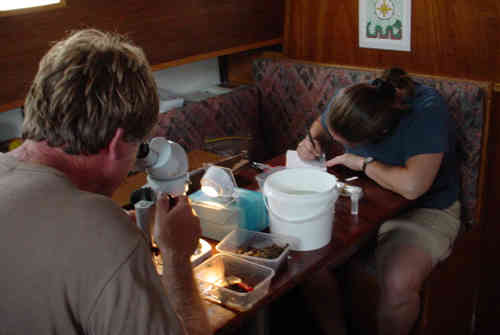
Michael Keats, myself and Des provided crew, and Peter provided research
tools, his knowledge, plus his research assistant Holly Barlow to document locations
and specimens.
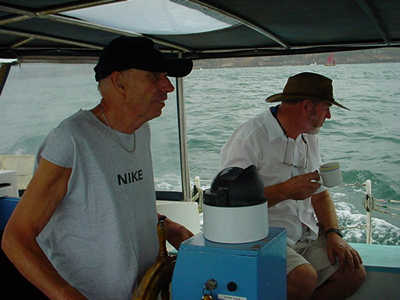
It took a day to sail from Sydney to Broken Bay, and half a day to
sail back a few days later. The mooring was in Carrel Bay each night. Peter and
Holly, joined the boat at Carrel Bay.
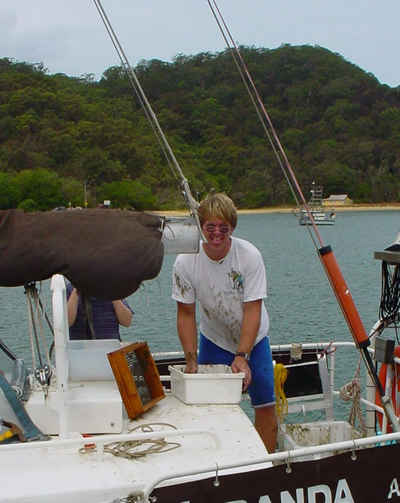
There were three days of dredging, and a total of only 19
dredge runs at 12 locations. If this was a hobby shell collectors trip
(in parts of the world where dredging is allowed) there would have been
many more dredge runs. However in 'research mode' the contents of each dredge run
is analysed in detail before proceeding with the next run. This is
partly to ensure the live specimens for DNA testing can be found, placed in
alcohol and labelled before they deteriorate, and partly to plan the
next location. Overnight Peter and the
researcher re-reviewed the dredged sand and mud in more detail under a microscope
to find the smaller shells and to enable better planing for the next
days locations.
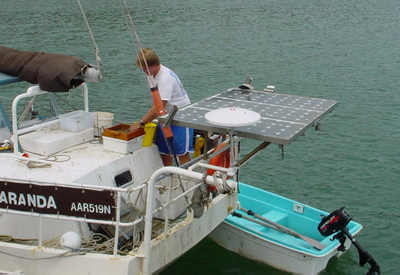
The bivalves Peter needed and other shells and invertebrates collected for other researchers at the museum were
bottled and labelled, leaving
small amounts of grit and sand containing a variety of microshells.
Michael, Des and I were able to review this material after the trip to see if there were any specimens we
would like to keep for further review and listing.
Much of the left over grit was the same types of microshells we get washed up on Sydney
beaches. Some of the more interesting observations were:
A few species of small Scaphopoda, from mud at the entrance to Carrel Bay
in an area know as 'The Pittwater Deep'
Behind Lion Island the dredge got snagged more than once, and when
released it contained clumps of coralline material with attached sponge.
One of these had two Cypraea xanthodon attached and a
number of Muricids.
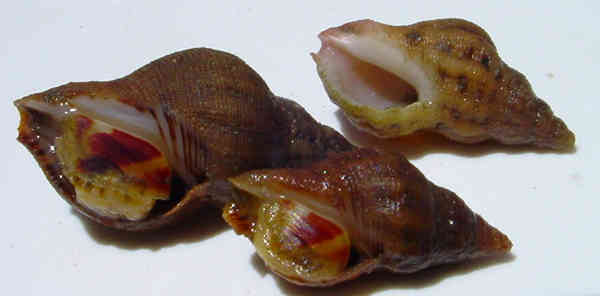
Some of the dredge runs in deeper water sand brought up live Zella bedeomei.
In the shallow sandy areas near Ettalong we found a few Hemidonax
pictus, the
only live sand shells larger than 8mm.
Some of the dredging was in deeper water outside Broken Bay. This was
limited due to the difficulties of hand hauling the dredge back into the
boat from deeper water and a bigger swell. At one location the sand
was fine and had no broken shell grit and at first we thought the dredge
was empty when lifted in. It contained 5 live Marginellidae. They are
pictured with animal below. Note how the animal colouring shows through
the shell. From the same location
there were two very attractive Belloliva triticea
and Belloliva leucozona.
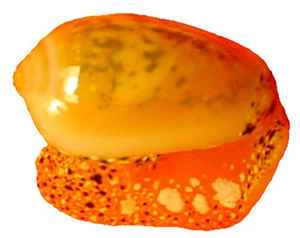
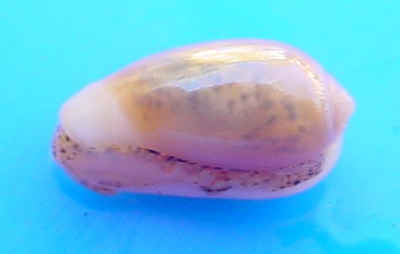
Margin 1 (The first shell is on a red tray that is making it look more
red than it actually is)
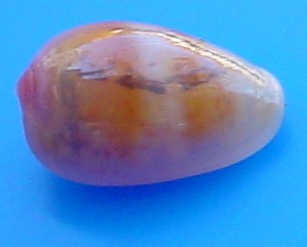
Margin 2
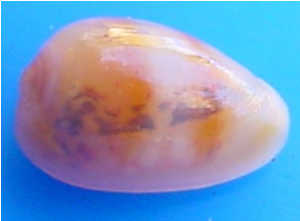
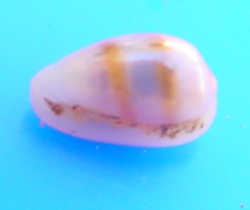
Margin 3
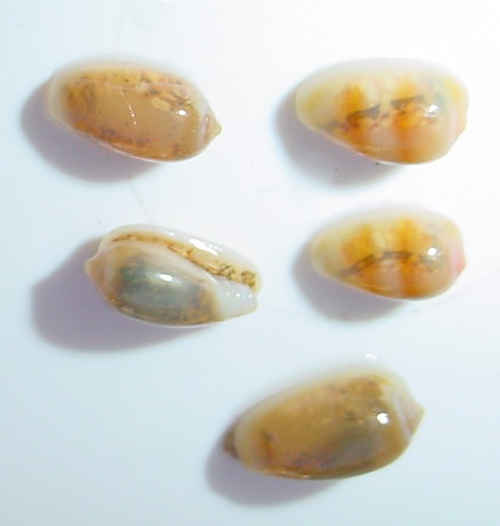
All 5 Margins alive, species yet to be identified (Two specimens have
orange bands)
Pictures from Michael's article last
month - Long Bay Field Trip:
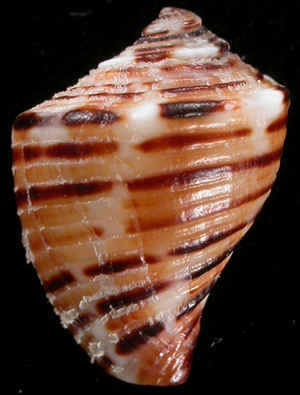
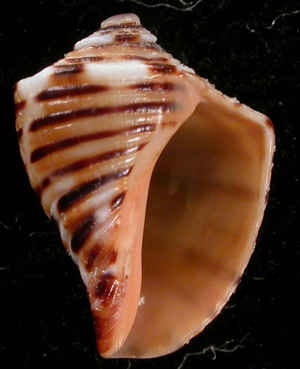
Pinaxia versicolor (Long Bay Sydney described by Michael, last issue)
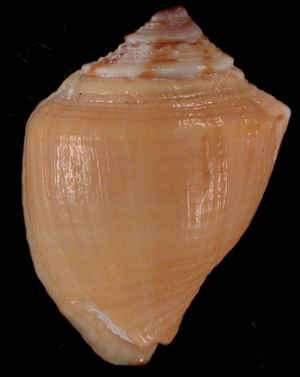
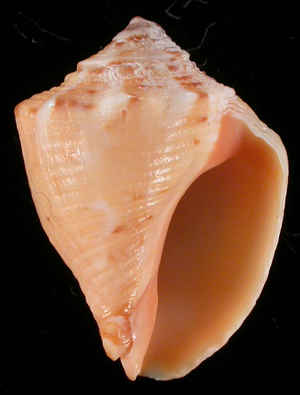
Pinaxia versicolor (Typical Australian National Museum Specimen for
Comparison)
Club Field Trip to Shell Harbour (2 hours south of Sydney)
16th March 2003 Near the Gravel Loader on the road to Bass Point.
By Steve Dean
(Live shell pictures Patty Jansen)
The trip was well patronised and the area was rich with marine life,
although very different to Sydney.
The coastline is Basalt with a few small sandy beach areas. One glaring difference was the large numbers of sea
urchins in most of the rock pools. I
suspect this may be the amount of urchins that could be expected to be
sustainable on some of Sydney's rock
platforms, but they are continually culled by humans around Sydney.
(squashed or eaten)
We looked at the rock platform in two locations and there were plenty of rocks to turn. There were five species
of Cypraeidae found, and a good selection of small shells.
Peter
Middelfart and his family came along as they live South of Sydney. His
children got to observe a blue ringed octopus and a fish that were
trying to avoid each other in a bucket of water. Peter Pienaar brought
his next door neighbours along, and although they had never looked on
rock platforms before they were very keen.
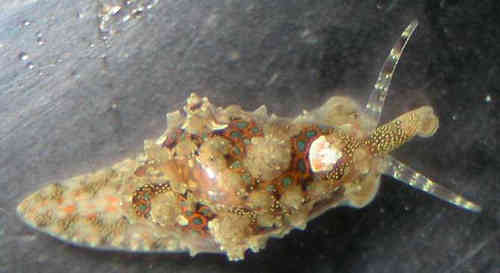
Alaginella ochracea
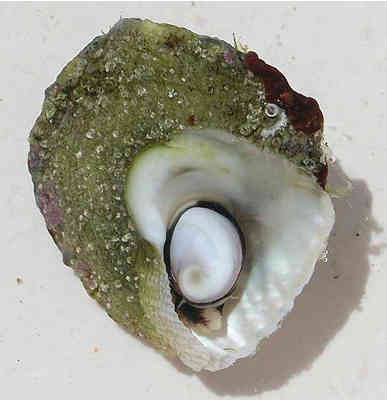
Astralium kesteveni

Astelena scitula
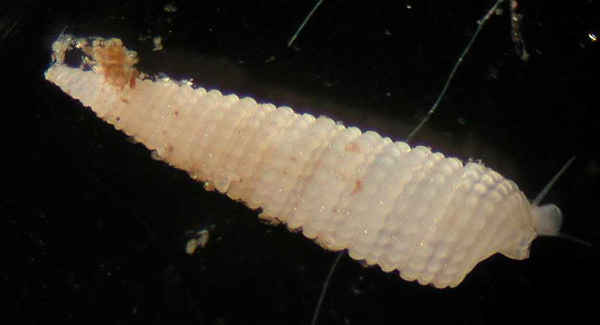
Bouchetriphora pallida
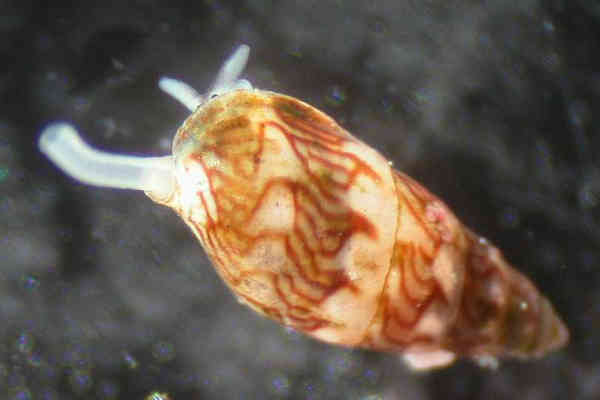
Macrozafra lurida
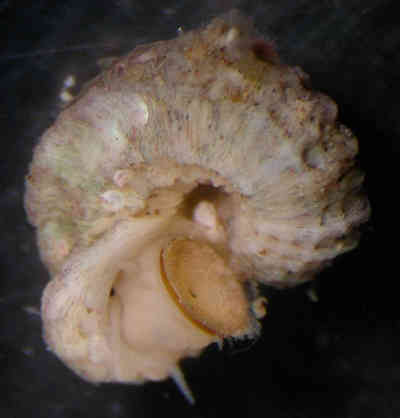
Liotina botanica
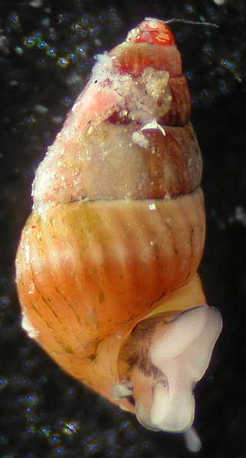
Pisinna frauenfeldi
Shell Club Library
Librarian - John Franklin
As a part of our Mission Statement the purpose of the library is not only to increase awareness and understanding but also to encourage research and to assist those pursuing their endeavours.
The library was commenced with the generous donation of Dr I. Bennett with a book entitled "Queensland and Great Barrier Reef Shells" 1961.
The schedule attached lists the material now available.
Please note that all materials have to date been donated to the Club. In the event that you have any books, articles and periodicals that have ceased to be of use, perhaps you could donate them to the Club to assist with research. Your gift would be most appreciated.
Schedule
Laseron, C.F., (1950). Review of the Rissoidae of New South Wales. Records of the Australian Museum 22, 257-287.
Laseron, C.F., (1951). Revision of the New South Wales Cerithiopsidae. Australian Zoologist 11, 351-367.
Laseron, C.F., (1951). The New South Wales Pyramidellidae and the genus Mathilda. Records of the Australian Museum 22, 298-334.
Laseron, C.F., (1953). Minute bivalves from New South Wales. Records of the Australian Museum 23, 33-53.
Laseron, C.F., (1954). Revision of the Liotidae of New South Wales, Australian Zoologist 12, 1-25.
Laseron, C.F., (1955). The New South Wales Cancellaridae. Records of the Australian Museum 23, 267-272.
Ponder, W.F., and Keyzer, R., (1992). A revision of the genus Diala (Gastropoda: Cerithiodea: Dialidae). Invertebrate Zoology 6, 1019-1075.
Amended List of Articles on Mullosca, Australian Zoologist Volumes 1 - 26 (1914 - 1990) and Proceedings of the Royal Zoological Society of NSW 1933 - 1969 (compiler unknown).
Bell, K.N., Index to Molluscan Research (formerly Journal of the Malacological Society of Australia) Molluscan Research Volume 20 (2).
Molluscan Research (formerly Journal of the Malacological Society of Australia) Volume 20 (2).
Rippingale, O.H. and McMichael, D.F., (1961). Queensland and Great Barrier Reef Shells, Jacaranda Press, Brisbane.
Phipps, R. and Tarrant, D., (1988). A Reference List of Marine Shells from the Solitary Islands and Adjacent Coastline, Solitary Islands Underwater Research Group.
What makes a good shell book?
Patty Jansen's Meeting Presentation Last Month
There has been an incredible proliferation of shell-related publications in
the last few years. Some of these books have been excellent, others just
OK, and some are rather mediocre. Which books you buy of course depends on
your interests and your specific needs and preferences, but this article
takes a look at how you determine which books are truly excellent not just
for your personal use, but which publications will stand the test of time.
The first port of call is the title of the book. Does it tell you what the
book covers? How good is the coverage of the subject area? Does it actually
tell you anywhere in the book? For a small field guide, you would not expect total coverage, but you would expect a specialist book on a family
to cover, or at least mention, all species in the family.
What about the author? Have you ever heard of the author? If not, can you
find out what the international opinion is on the author? Also look for an
endorsement from a recognised institute or an internationally recognised
malacological scientist in the front of the book, or for these names in the
acknowledgements. Whilst this is no guarantee that the taxonomy in the book
is up-to-date, or that you will agree with it, it does show that the author
has been in touch with the people who should know, and has had exposure to
the latest literature. It also shows the author didn't come down in the last shower, and you have a reasonably good chance that most of the book is
correct and up-to-date.
The most important consideration is whether or not the book allows you to
properly identify your shells.
Are the shells figured? In this case, most people prefer colour photographs, but there have been some cases where the photography is bad,
out-of-focus, or the shells are reproduced too small to be able to see them
properly. There have also been some books with black and white photography
or colour drawings or line or pencil drawings that are better than colour
photographs.
The text:
Are the shells named properly? Of course if you knew everything about every
species illustrated you would not need to buy the book, but there are a few
checks you can make to see if the author has followed the latest accepted
format for shell names. All names must be followed by an author and a year.
If the genus in which the species is currently placed is not the same as
the genus under which it was described, the author and year have to be in
brackets. If you see a book where all authors and names are in brackets you
can be sure the author did not understand this part. Whilst this may not be
a major crime, what does it say about the author's understanding of the rest of the subject matter?
Is the taxonomy up-to-date? Again, you are probably buying the book for a
little help with this, but for the same reasons outlined above, you might
have reason to doubt an author's credibility if the book still uses Cymatiidae instead of Ranellidae (a change which was made almost 20 years
ago!).
The description needs to be concise and to-the-point. I think a few of the
recent publications are falling down in this respect. It is all very well
to have a detailed, convoluted description of how far down the spire ribs
no. 2 and 4 start, but how does that tell you why this species is different
from the next one? Is the fact that the starting point of the ribs is not
mentioned in the next species important in their identification (the picture shows it does have ribs). In fact, it shows that the difference
between the species has nothing to do with the ribs, but with the flaring
aperture in species no. 2, a fact which the description only mentions in
passing. Long descriptions are a waste of paper, because hardly anyone reads them. All you need is a few sentences highlighting the main features
of the shell and why it is different from the next shell. Scientific reports often have long descriptions. They usually also have a 'diagnosis'
section that allows you to identify a species quickly.
What is the worldwide range of the species? The South African books are notoriously parochial. They only mention the South African distribution of
their species, whilst many of them are Indo-Pacific species. I would love
to know how far up the African coast they range, but since the world for
years pretended South Africa didn't exist, we could hardly expect they acknowledge the rest of the world exists. I hope future publications will
rectify this.
The bibliography:
Every good book should have a bibliography. The bibliography should contain references that allow readers to study the
subject area in more detail. A specialised book on a family should have a
long list of references including many scientific papers published in internationally recognised malacological publications. Whilst there is
nothing wrong with citing articles in some of the popular coloured shell
magazines, a reference list that has nothing more substantial than this again shows the author hasn't really studied the family properly.
These points are important to consider when buying a book. Although a particular book may fall down on almost all the above points, you may still
want to purchase it for other reasons, or simply because there is nothing
else on the subject area. But being aware of it's faults can make you a wary user, and allow you to cross-check wherever you feel it is necessary.
Remember of course that no book is ever perfect, and if you do so politely
and specifically, armed with the information you believe to be correct, the
large majority of authors would welcome your comments.
Answers to Questionnaire in the last
Sheller
John Franklin
The Questionnaire which was published in the Sydney Sheller in the February issue was very well received and set out below are the answers. How did you go? If you would like a particular area covered, please advise.
Answers:
Q1(a) The Jesuit Filippo Buonanni
Q1(b) Recreatio mentis et oculi in observatione cochlearum (Entertainment of mind and eyes through the study of shells).
Q2 "Historia conchyliorum"
Q3 The Frenchman Joseph Dellazier d'Argenville
Q4(a) Binomial nomenclature
Q4(b) The Systema naturae (10th edition) was published in 1758
Q4(c) The system laid the foundations for how we name specimens today. The first name described the group/genus and the second name specifically indicated the particular shell.
Q5 The German painter Knorr
Molluscs:
(a) Fabe; the Phylum mollusca is the second largest in the animal kingdom
(b) Phylum Mollusca can be divided into 7 classes as follows:
Class Monoplacophora - limpet-like, fragile shell, deep water
Class Aplacophora - worm-like
Class Polyplacophora - chitons
Class Scaphopoda - tusk shells
Class Cephalopoda - cuttlefish, squids, nautiluses and octopuses
Class Bivalvia - also known as Pelecypoda (hatchet-like foot) and Lamellibranchia (plate-like gills) contains
mussels, cockles, oysters etc.
Class Gastropoda - the largest and most diversified class of molluscs. Slug and snail-like creatures.
Characterised by having a stomach.
(c) The visceral mass of a mollusc's body contains the circulatory, digestive, reproductive and excretory organs. Four other essential parts are: the shell, the mantle, the head and the foot.
(d)(i) The radula is a ribbon-like organ having rows of transversal tooth-like structures
(d)(ii) The number and shape of the rows of transversal tooth-like structure of the radula tend to characterise the particular genus and species of the specimen being identified. Another aid in taxa identification is DNA testing which has become a very popular method.
(e) Haemolyomph (blood) conveys iron rich haemoglobin and haemocyanine being a respiratory substance which contains copper.
(f) If a shell coils from left to right, it can be said to be sinistral (left handed spiral).
(g) If a shell coils from right to left, it can be said to be dextral (right handed spiral).
(h)The operculum can be thin or thick, that is, it can be either horny or shelly.
(i) The cells in the mantle produce pigments at the same time they deposit calcium carbonate. The pigments produce colour variations which are covered by different degrees of water salinity, different diets and other factors.
(j)(i) Shells consist of three kinds of layers namely:-
Hypostracum or nacre
Ostracum, a thick layer being crystalline in structure
Periostracum, an organic membrane often brown in colour
(j)(ii) The Cypraea family do not have a periostracum.
New Questionnaire John
Franklin
Set out below are questions, the answers to which should be published in the next issue of the Sheller. The purpose of the exercise is to stimulate interest and research. Having regard to the requirements of the Dept. of Fisheries and other institutions for the issue of a permit, perhaps one day your research could lead to the issue of a Certificate of Merit, even a degree. Should any member have questions (with answers) that they feel could make a contribution, please advise.
Q1. In what geological period did Molluscs first appear?
Q2.(a) When are marine molluscs said to be benthic?
Q2.(b) When are marine molluscs said to be pelagic?
Q3. What was Samuel Pickworth Woodward's contribution to Molluscan study?
Q4. What set of rules was established by the International Commission on Zoological Nomenclature?
Q5. Bad and illegal collecting methods are only two ways in which our marine heritage can be affected. How many other factors can you describe?
Q6. Latin terminations apply to each systematical group of species. What last four letters apply to a superfamily, a family and a sub-family?
Sydney Shell Collectors Club Inc Web Site Steve
Dean For those that have a computer but have not seen our
new club web site, it is located at www.sydneyshellclub.net It
is growing rapidly. Currently it has the following sections completed or
near completion:
- Information about our club and our code of ethics to promote new
members.
- A live specimen photo gallery (Just Starting)
- Reference catalogue of Shell Books and publications (Starting with
Australian publications, then the world by region, then family
specific lists. Most of this is still in typing, and once on line
will continue to be added to.)
- All of these Shell Club News Letters 'Shellers' from July 1998 (On
the net the early Black and White issues now have colour pictures.
Many Issues have more picture angles of each shell, and many
pictures are larger with more detail. Obsolete information such as
program, tides, cake rosters and advertising are removed from the
net version)
- Summary of article titles from Shellers including Shellers not
on the net all the way back to Issue 1, Volume 1 June 1979
- Iconographies of individual families (Currently none complete)
- Library list - for local members.
- Links
Meeting Minutes 22/03/2003.
The meeting was opened by P Jansen at 2.10 pm.
Field Trips
Michael Keats reported on the recent field trip to Shellharbour. He found a number of
Semicassis labiata (Perry, 1811), Cypraea, starfish, feather-stars
and octopus.
P. Jansen reported finding a number of live microshells (marginellids). Photos will be forwarded to Steve Dean for publication in
" The Sheller". Ashley Miskelly collected a number of urchins, a Cymbiola magnifica
(Gebauer, 1802), Charonia lampas rubicunda Perry, 1811 but added that there was not much material observed near the coal loader, although the water was clear.
Michael reported on his recent trip to Kangaroo Island where he found some terebrids. Michael will expand on this at his presentation
later in the year.
Ashley reported on a visit to Neilson Park in Sydney Harbour. He found some sand dollars and coral at 30m. He also found some urchins with a species of commensal crab attached. He also found a live Pinna shell, which was 45cm in length, at Parsley Bay.
C. Barnes reported a number of species collected from Long and Little Bays. These included:
Cypraea cernica Sowerby, 1870 Nassarius spiratus (Adams, 1852),
Natica euzona Recluz, 1844 and Vexillum cadaverosum (Reeve, 1844).
A field trip is proposed for Thursday 17th April at Long Bay starting at 12 noon for lunch to shell the 2.30pm low tide.
Another field trip to Dingo Beach, near Proserpine, Queensland is planned for the 14 -15th of July.
General Business.
M. Keats assisted Mosman Council at their "Workshop for Councillors and Community", where he talked about Molluscs and promoted the shell club. He has previously spoken on beach raking at Chinaman's beach.
Michael distributed copies of "Waves" and "Ripples".
Steve Dean reported on the Sydney Shell Collectors Club Inc website: www.sydneyshellclub.net
He has now placed all the recent editions of "The Sydney Sheller" on it.
Steve passed a copy of an article around regarding the use of ultrasound for cleaning shells.
Presentation.
Patty Jansen talked about the different publishing formats and styles of books and why some are more appropriate than
others for various applications. Patty covered topics such as hard versus soft covers, print run numbers, usage, bibliographies and recommendations by authorities. Costs of publishing and pricing levels required to recoup expenditure.
Meeting closed at 3.25pm.
C. & K. Barnes Secretary
|



























